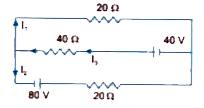State Kirchhoff’s first (current) law.
Step-by-Step Solution:
1. Understanding Kirchhoff’s First Law: Kirchhoff's first law, also known as Kirchhoff's Current Law (KCL), deals with the conservation of electric charge at a junction in an electrical circuit.
2. Defining a Junction: A junction is a point in a circuit where two or more conductors meet. At this point, currents can either enter or leave the junction.
3. Incoming and Outgoing Currents: If we denote the currents entering the junction as I1 and I2, and the current leaving the junction as I3, Kirchhoff’s first law states that the total current entering the junction must equal the total current leaving the junction.
4. Mathematical Expression: This can be mathematically expressed as:
Iin=Iout
or, more specifically:
I1+I2=I3
5. Algebraic Sum of Currents: Alternatively, the law can be expressed in terms of the algebraic sum of currents at the junction, which states:
I1+I2−I3=0
Here, currents entering the junction are considered positive, and currents leaving the junction are considered negative.
6. Conclusion: Thus, Kirchhoff’s first law emphasizes that the total current flowing into a junction must equal the total current flowing out, reflecting the principle of conservation of charge.
---
Iin=Iout
or, more specifically:
I1+I2=I3
I1+I2−I3=0
Here, currents entering the junction are considered positive, and currents leaving the junction are considered negative.
Topper's Solved these Questions
- QUESTION BANK 2021BOOK - NAVNEET PUBLICATION - MAHARASHTRA BOARDCHAPTER - QUESTION BANK 2021EXERCISE - CURRENT ELECTRICITY (Short Answer I (SA1) ( 2 MARKS Each ) )
8 Videos
- QUESTION BANK 2021BOOK - NAVNEET PUBLICATION - MAHARASHTRA BOARDCHAPTER - QUESTION BANK 2021EXERCISE - CURRENT ELECTRICITY ( Short Answer II (SA2) ( 3 MARKS Each ) )
7 Videos
- QUESTION BANK 2021BOOK - NAVNEET PUBLICATION - MAHARASHTRA BOARDCHAPTER - QUESTION BANK 2021EXERCISE - CURRENT ELECTRICITY (MCQ’S (1 Mark Each) )
7 Videos
- MULTIPLE CHOICE QUESTIONSBOOK - NAVNEET PUBLICATION - MAHARASHTRA BOARDCHAPTER - MULTIPLE CHOICE QUESTIONSEXERCISE - Communication Systems
6 Videos
- SHORT ANSWER QUESTIONSBOOK - NAVNEET PUBLICATION - MAHARASHTRA BOARDCHAPTER - SHORT ANSWER QUESTIONSEXERCISE - Assignments
3 Videos
Similar Questions
Knowledge Check
Sign conventions used to apply Kirchhoff's current law are
Aentering and leaving currents are positiveBentering and leaving currents are negativeCentering currents are positive and leaving currents are negativeDall of theseThe mathematical equation of Kirchhoff's current law is
A∑I=0B∑IR=0C∑E+∑IR=0D∑E=0Kirchhoff's first rule is based on ………
ALaw of conservation of energyBLaw of conservation of momentumCLaw of conservation of electric chargeDPrinciple of quantisation of charge
State Kirchhoff's rules of current distribution in an electrical network. Using these rules determine the value of the current I1 in the electric circuit of Fig.

View SolutionWhat are the basis of Kirchhoff's current law and voltage law ?
View SolutionState Kirchhoff' voltage law
View SolutionKirchhoffs voltage law and current law are respectively in accordance with the conservation of
View SolutionThe Kirchhoff's first law (∑i=0) and second law (∑IR=∑E) are respectively based upon the conservations of
View Solution

